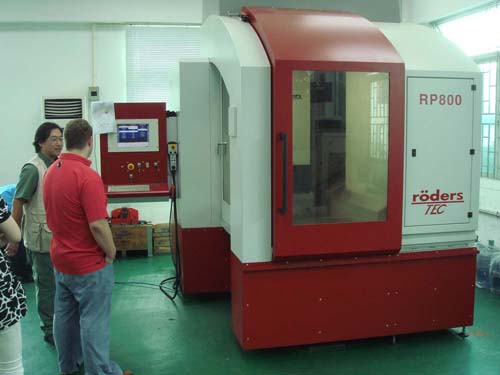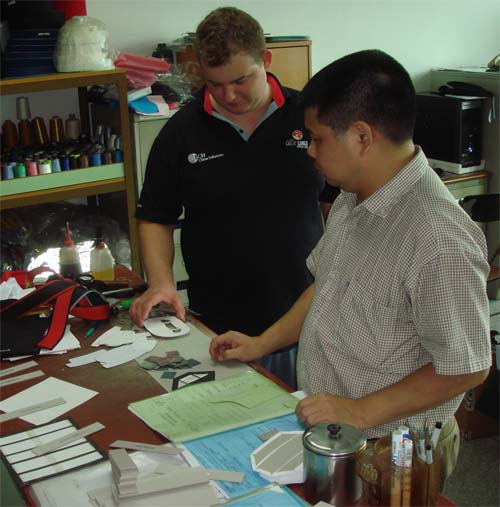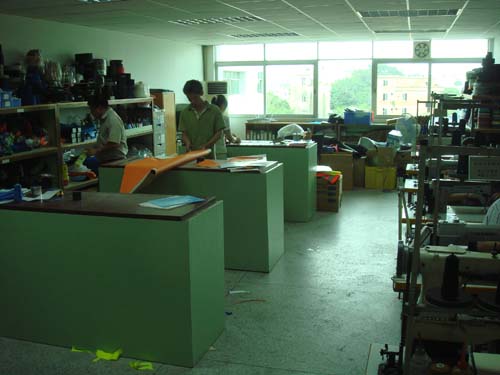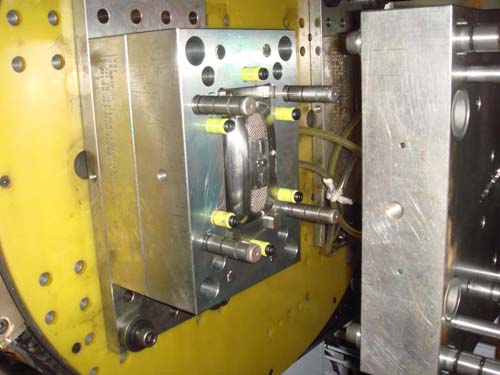Dayum, Caustik has produced a hot new mix (“APU 003”, a series named after the APU chip in the original 8-bit NES) and it’s posted up on Hybridized.org‘s forum…check it out here, awesome stuff!
Name that Ware August 2007
September 11th, 2007The ware for August 2007 is shown below. Click on the photo for a much larger version (warning, about 2 MB in size).
It’s late in coming, as Chumby has kept me very busy lately, but better late than never. Yep, this is a portion of a silicon chip, imaged at just 20x magnification! The challenge for this…er last…month is to correctly name what type of functional block this is, and some basic properties about it. Thanks to Chris at Flylogic.net for the awesome chip shot! We’ll be teaching an introductory workshop on silicon reverse engineering at this years’ Toorcon in San Diego.
Made in China: Precision
September 11th, 2007A subject that I had to learn about in the course of engineering the chumby is injection molding. For an electronics guy with little mechanical background, this is not a small hill to climb. The concept seems simple: you make a cavity out of steel and you push molten plastic into it at high pressure, let it cool, and voila, a finished part comes out. Just like the Play-Doh molds from elementary school!
Oh if only things were that simple.
There’s all kind of nuances to the process. Plastic flows, but it’s not particularly runny. So it moves slowly, and it cools as it flows. The color of the plastic is impacted by this, and you can see flow lines and knit lines in an improperly designed mold. There’s also a whole assortment of issues with how the part is pulled from the tool, how the tool is made and finished, where the gates and runners are for getting the plastic in there…
Fortunately, we have experts in China who know all about this, and I get to learn mostly by watching.
If I were to summarize injection molding with a single adjective, it would be “precision”. The molds are precise to better than hair-thin tolerances, yet they are made out of hard steel. Achieving this level of precision out of such a durable material is no mean feat. It’s impressive to see a mold being cut out of raw steel.
The machine above is moving around a block of steel that weighs probably several hundred pounds in quite a hurry! Below is a photo of the whole machine, so you can get a sense of how big it is.

However, this is only the roughest step in mold making. After the rough shape is cut out, the mold is put into a machine called an “EDM”–Electron Discharge Machine–where a burst of electrons are used to knock microscopic chunks off the steel surface. If this sounds like a terrifically tedious process to you, it is. I’ve watched many EDMs do their job and it’s like watching paint dry (which is why I don’t have a video of it here). However, these things are wicked precise and they yield spectacular, repeatable results. All told, a mold transforms form a block of raw steel into a first-shot tool in about 4-6 weeks. I think, from a project management standpoint, the phenomenally long lead times of production-quality injection molded plastics was the biggest eye opener for me. I had to go to China and see the tooling shop do its work before I was convinced that there wasn’t some gross amount of schedule padding going on. What’s even more harrowing from the risk management standpoint is that there are no good simulation tools (to my knowledge) to predict how plastics will flow through the mold. So those visible blemishes like flow lines and knit lines? Well, you have to wait 4-6 weeks to see if you got it right. Ouch! Fortunately, the toolmakers we use in China anticipate this and they make the tools so as to err on the side of having excess steel, because it’s much easier to remove material to fix a problem, than it is to add material. Sort of like the old carpenter’s saying of measure twice, cut once, and if you have to cut wrong, cut long.
Here’s what a final mold looks like in the injection molding machine:
This is the mold that is used to create Chumby’s back bezel. It’s actually a very complex mold, because it involves a process called overmolding. If you happen to buy a chumby (I hope you do!), take a look at the back side and you’ll see what I mean. There is a rubbery TPE surrounding the hard ABS bezel. Many people assume this was glued on rubber band. In fact, the TPE is molded in-place on the back piece. This requires a two-shot mold. Watch in the video below what happens:
You can see that there are actually two molds, and one side of the mold spins around so that the alternating material systems can be molded at the right points in the process. Just as a bonus, I swiveled around at the end of the video to show you an unrelated product where a robotic arm is doing the mold extraction. The part is a very high-gloss part and a robot arm is used to prevent getting fingerprints or nicks on the work piece as it is still soft from the heat of the mold.
High-gloss steel molds are really impressive to see in real life, because the exposed mold surfaces are mirror-polished. I don’t have a video of this, but all of the steel surfaces that are exposed to the end users’ eyes are hand-polished by a crew of women. They spend days rubbing and picking at blocks of steel using specially cut bamboo rods, cotton swabs, and very fine grit polish. This step happens after the EDMs are done doing their thing, or anytime the mold has sat unused for a long time or has been opened for rework.
There is a lot of hard work that goes into those humble plastic parts!
Made in China: Craft
September 11th, 2007I’d like to introduce you to a man who I know simply as “Master Chao”.

Master Chao is the person in the foreground; in the background is Joe Perrott, who you will see in many of the photos and videos I have from China. Joe is our excellent project engineer from PCH China Solutions. But I digress.
Why am I introducing you to Master Chao? Because I’m pretty sure you have used or seen something in your lifetime that was crafted by the Master. When I went to the sample room for this factory, I was shocked at how many items I saw on their shelf that I had myself purchased, used, or seen in a store in the US — top-tier consumer brands manufacture their stuff here — and to the best of my knowledge the factory has just one master pattern maker, and this is him. Indulge me with a moment of philosophy.
The advent of modern CAD tools have brought about a rather coarse attitude towards the arts and crafts. It used to be that the finest furniture was designed and built only with the intuition and skill of a master craftsman; now, we all go to Ikea and get our CAD-designed, supply chain managed, picture-book assembly furniture kits and despite all that it doesn’t look too shabby. As a result, the word “craft” has been relegated to describe some scrapbook or needlepoint kit you buy at Michaels and put together on a slow weekend. We’ve sort of forgotten that in an age before machines, “craft” was the only way that anything of any quality used to be built.
It turns out there are still things where Craft, and I use it with a capital “C” here, matters–it’s where CAD tools haven’t brought about the ability to simulate out our mistakes before we build them. The creation of a flat pattern for textile goods is a good example of a process that requires a Craftsman. A flat pattern is the set of 2-D shapes used to guide the cutting of fabrics. These 2-D shapes are cut, folded and sewn into a complex 3-D shape. Mapping the projection of an arbitrary 3-D shape onto a 2-D surface with minimal waste area between the pieces is hard enough; the fact that the material stretches and distorts, sometimes in an anisotropic fashion, and the fact that sewing requires ample tolerances for good yields makes it a difficult problem to automate. On the chumby, we add another level of complexity, because we sew a piece of leather onto a soft plastic frame. As you sew the leather on, the frame will distort slightly and stretch the leather out, creating a sewing bias dependent upon the direction and rate of sewing. This force is captured in the seams and contributes to the final shape of the device. I challenge someone to make a computer simulation tool that can accurately capture those forces and predict how a device will look at the end of the day.
Yet, somehow, Master Chao’s proficiency in the art of pattern making enables him to very quickly, and in very few iterations, create and tweak a pattern that compensates for all of this. It’s astounding how clever and how insightful the results can be. And really, the point of this particular post is to introduce you to a person whose old-world skills — absent computers, all done with cardboard, scissors and pencils — has likely played a role in the production of something that you have used or benefited from in the course of your life.

Not a single computer in this office, yet the products developed here wrap around a wide array of high-tech products.


